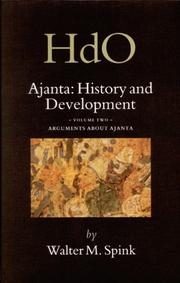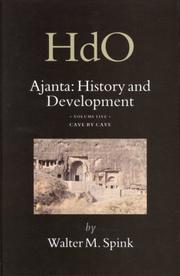| Listing 1 - 6 of 6 |
Sort by
|

ISBN: 9004150722 9004148337 9789004205710 9004148329 900414983X 9004156445 9789004149830 9789004180154 9789004319684 9789004321922 9004321926 9004319689 9786611458270 1281458279 9047411870 9786611399139 1281399132 9047409353 9786612396717 1282396714 9047442113 9047416279 9789047416357 9789004150720 9789004156449 9789004148338 9789004148321 9789047416272 9789047442110 9781282396715 6612396717 Year: 2009 Volume: 18 Publisher: Leiden Boston Brill
Abstract | Keywords | Export | Availability | Bookmark
 Loading...
Loading...Choose an application
- Reference Manager
- EndNote
- RefWorks (Direct export to RefWorks)
Ajanta: Year by Year is planned as a biography of this remarkable site, starting with the earliest caves, dating from some two thousand years, to its startling renaissance in the brief period between approximately 462 and 480. Concentrating on the excavations of the later period, during the reign of the Vakataka emperor Harisena, it attempts to show how, after a surprising gap of some three hundred years, Ajanta’s proud and pious courtly patrons and its increasingly committed workmen created not only the greatest but the latest monument of India’s Golden Age. Nearly three hundred illustrations, in color and black and white, reveal the exuberant flowering of Ajanta and related Vakataka monuments, as well as the manner of their sudden demise.
Ajanta (India) -- History. --- Vakataka dynasty -- History. --- Ajanta Caves (India) --- Buddhist antiquities --- Antiquités bouddhiques --- Ajan̲t̲ā (Inde : Site archéologique) --- History --- India --- Inde --- Histoire --- Bharat --- Bhārata --- Government of India --- Ḣindiston Respublikasi --- Indië --- Indien --- Indii︠a︡ --- Indland --- Indo --- Republic of India --- Sāthāranarat ʻIndīa --- Yin-tu --- インド --- هند --- Индия --- Ajantha Caves (India) --- History. --- Archeologische vindplaatsen. --- Heiligdommen. --- Höhlentempel. --- Ajanta Caves (India) - History

ISBN: 1281399132 9786611399139 9047409353 9789047409359 9789004150720 Year: 2006 Publisher: Leiden Boston
Abstract | Keywords | Export | Availability | Bookmark
 Loading...
Loading...Choose an application
- Reference Manager
- EndNote
- RefWorks (Direct export to RefWorks)
Volume Two begins with writings by some of the most important critics of Walter Spink's conclusions, interspersed with his own responses, using a thorough analysis of the great Cave 26 to support his assertions. The author then turns to matters of patronage, and to the surprising fact that, unlike most other Buddhist sites, Ajanta was purely 'elitist', developed by less than a dozen major patrons. Its brief heyday traumatically ended, however, with the death of the great emperor Harisena in about 477, creating political chaos. Ajanta's anxious patrons now joined in a headlong rush to get their shrines dedicated, in order to obtain the expected merit, before they fled the region, abandoning their caves to the monks and local devotees remaining at the now-doomed site. These 'intrusive' new patrons now filled the caves with their own helter-skelter votive offerings, paying no heed to the well-laid plans of the years before. A similar pattern of patronage is to be found in the redecoration of the earlier Hinayana caves, where the careful planning of the work being done during Harisena's reign is suddenly interrupted by a host of individual votive donations. The volume ends with a new and useful editing of Ajanta inscriptions by Richard S. Cohen.

ISBN: 1281458279 9786611458270 9047411870 9789047411871 9789004156449 9789004149830 9789004150720 9789004148321 9004150722 9004148329 9789004148338 900414983X 9004148337 9004156445 9789004180154 9789004319684 9789004321922 9004321926 9004319689 Year: 2016 Volume: 18 Publisher: [Place of publication not identified] Brill
Abstract | Keywords | Export | Availability | Bookmark
 Loading...
Loading...Choose an application
- Reference Manager
- EndNote
- RefWorks (Direct export to RefWorks)
Volume Five comprises, along with introductory comments, two "cave by cave" guides. One which, very briefly, describes the character of each cave and its patronage, is intended to be useful for the general visitor to the site. The other, very detailed, discusses the position and peculiarities of each cave in relation to the overall, year by year, development of the site. This volume also contains a complete set of cave plans, and various illuminating charts, graphs, outlines, and maps.
Archeologische vindplaatsen. --- Heiligdommen. --- Antiquit{acute}es bouddhiques --- Aja{dotb}n{dotb}t{macr}a (Inde : Site arch{acute}eologique) --- Inde --- Ajanta Caves (India) --- Ajantha Caves (India) --- Histoire --- History. --- Antiquités bouddhiques --- Ajaṇṭā (Inde : Site archéologique) --- Buddhist antiquities --- India --- Ajan̲t̲ā (Inde : Site archéologique) --- History
Periodical
Abstract | Keywords | Export | Availability | Bookmark
 Loading...
Loading...Choose an application
- Reference Manager
- EndNote
- RefWorks (Direct export to RefWorks)
Book
ISBN: 9047444655 9789047444657 9789004180154 900418015X 1306584744 Year: 2013 Publisher: Leiden
Abstract | Keywords | Export | Availability | Bookmark
 Loading...
Loading...Choose an application
- Reference Manager
- EndNote
- RefWorks (Direct export to RefWorks)
Volume 6, in Walter Spink's detailed analysis of the creation and development of the Ajanta caves, during the reign of the emperor Harisena (c.460-c.477) has had a profound and often upsetting impact on the understanding of Indian history in the so-called Golden Age. The author contends that through the discipline of Art History one can in fact change the established view of cultural developments in the crucial 'Classic Age' (5th Century CE). One of his major aims is to prove that it was the Vakatakas, under the emperor Harisena, and not the Guptas, that brought Indian culture to its apogee in the late 470s and to show that by analyzing and organizing Ajanta's 'defining feature' in revealing developmental sequences, one can support, with specifics, the revolutionary (but now increasingly accepted) 'short chronology' for which the author is well known. These 'defining features' range from the changing types of Buddha images and living arrangements for the monks, to the precise analysis of the evolution of pillars, doorways, and excavation techniques. The volume also includes, at the start, a discussion of the transforming effect of competition, and finally war, as a key to Ajanta's highly driven development, its florescence, and finally its sad demise.
Ajanta Caves (India) --- Ajantha Caves (India) --- History. --- Law --- Justice, Administration of --- Practice of law --- Law practice --- Practice
Book
Year: 1977 Publisher: Zug, Switzerland : Inter Documentation Company AG,
Abstract | Keywords | Export | Availability | Bookmark
 Loading...
Loading...Choose an application
- Reference Manager
- EndNote
- RefWorks (Direct export to RefWorks)
| Listing 1 - 6 of 6 |
Sort by
|

 Search
Search Feedback
Feedback About UniCat
About UniCat  Help
Help News
News